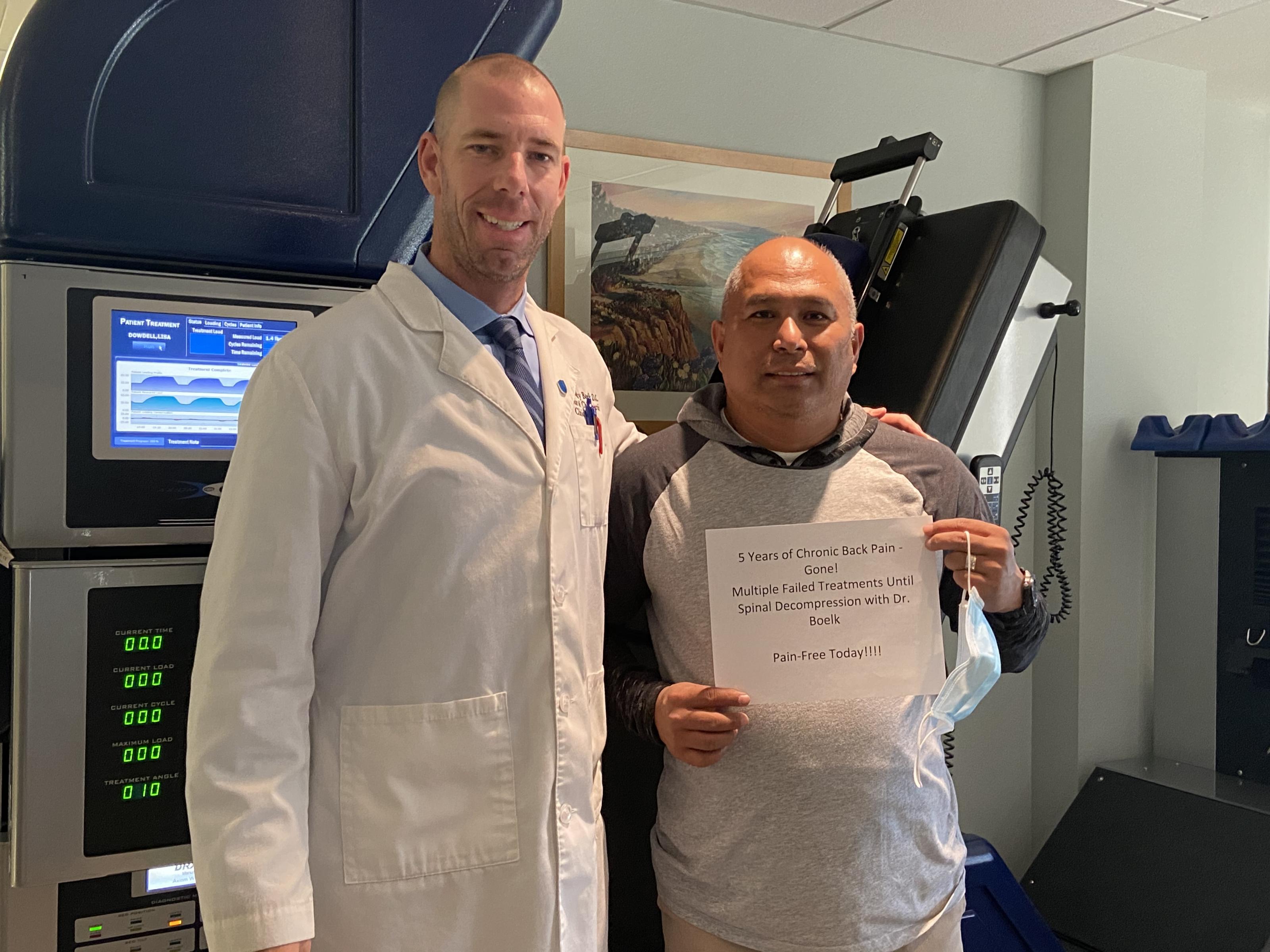How Can I Fix a Herniated Disc? San Diego, CA
If you're suffering from back or neck pain and have been told you have a herniated disc, you're not alone—and you're probably wondering what you can actually do to fix it. The good news is that in many cases, surgery isn't necessary. At The Spinal Decompression & Chiropractic Center of San Diego, Dr. Cassidy Boelk, DC, has helped thousands of patients not only relieve pain but correct the root problem through Non-Surgical Spinal Decompression (NSSD) and personalized rehab strategies.
Let’s break it down—how herniated discs happen, what you can do about them, and why addressing the actual cause of the pain is the only path to real, long-term relief.
💥 What Is a Herniated Disc and How Does It Happen?
A herniated disc—also called a slipped or ruptured disc—occurs when the inner gel-like material of a spinal disc (called the nucleus pulposus) pushes out through a weakened or torn outer layer (the annulus fibrosus). This can happen in the neck (cervical spine), mid-back (thoracic spine), or lower back (lumbar spine).
Common Causes:
- Repetitive strain or poor posture
- Lifting injuries or heavy pressure loads
- Degenerative disc changes over time
- Sudden trauma, like a fall or car accident
Once herniated, the disc material often compresses or irritates nearby spinal nerves—leading to symptoms like radiating leg or arm pain, numbness, weakness, or tingling.
🔍 Why Most Treatments Only Mask the Pain
Standard treatments—like pain medications, injections, physical therapy, acupuncture, massage, or even chiropractic adjustments—often focus on symptom relief, not correction.
While they may reduce inflammation or help temporarily, they don’t decompress the disc or address the ongoing pressure causing the herniation in the first place. This is why so many people bounce from one provider to the next, trying everything, only to end up frustrated and still in pain.
✅ What You Can Do at Home
If you're in the early stages or managing between visits, there are simple, non-invasive ways to support your spine:
At-Home Tips:
- Avoid prolonged sitting or bending/twisting motions
- Use a lumbar roll for support when sitting
- Gentle walking or swimming to stimulate blood flow
- Apply ice packs for 15 minutes during flare-ups
- Try a modified McKenzie press-up under guidance if tolerated
- Focus on core activation exercises, not crunches
- Maintain hydration—discs rely on water content for height and shock absorption
These strategies can help reduce pressure and inflammation but won’t reverse the disc herniation on their own. That’s where targeted decompression and biomechanical correction come in.
💡 Why NSSD Works So Well
Non-Surgical Spinal Decompression (NSSD) with the DRX9000 systemis specifically designed to treat disc herniations by correcting the underlying cause—spinal disc compression.
How It Works:
- Gently separates spinal segments to create negative intradiscal pressure
- Encourages the retraction of the herniated material
- Restores nutrient and oxygen flow for disc healing
- Reduces pressure on the nerve roots causing radiating symptoms
NSSD is completely non-invasive, drug-free, requires no downtime, and has been clinically supported by Stanford, Johns Hopkins, Mayo Clinic, and Duke Medical Center.
At our clinic, we exclusively use the DRX9000—the most advanced, research-backed decompression system available—with individualized settings and protocols for each patient.
🔧 Lasting Relief Requires More Than Just Passive Therapy
While decompression is the cornerstone, we don’t stop there. To truly fix a herniated disc and prevent it from coming back, we also address the mechanics of your spine and how your body moves.
Our Approach Also Includes:
- Targeted spinal rehab exercises to strengthen support muscles
- Core and hip stabilization training to unload the spine
- Postural correction and movement retraining
- Hands-on therapy as needed for tight muscles and restricted joints
By correcting movement faults and building strength around the spine, we help you not only recover—but stay recovered.
🏆 Why Patients Trust Dr. Boelk
Dr. Cassidy Boelk, DC is one of the most experienced spinal decompression specialists in the U.S., having performed over 65,000 decompression sessions in the past 21 years. As a Certified Spinal Decompression Doctor and Certified Pain-Free Performance Specialist, he has helped patients from across California, the U.S., and overseas avoid surgery and return to active lives.
Real Patient Success Stories
"I was so tired of being in pain and felt I had tried all resources. After two unsuccessful cortisone shots, I found spinal decompression. I’m so grateful I found Dr. Boelk. After a consultation where I felt heard and never rushed, I committed to the plan. I am so glad I did."
— Marlo Surovsky, San Diego, CA
"I now travel from El Centro four times a week because of the amazing results. I feel better and have recommended this treatment to my family and friends. Thank you!"
— Mercedes Bautista, El Centro, CA
"I travel from the UK to see Dr. Boelk and his wonderful team. I have 3 bulging discs and one is touching the nerve. The spinal decompression treatments really help keep me in my active life. I will not go to anyone else for back treatment."
— Skate Lisa, UK
📍 Visit Us Today – No-Charge Consultation
If you’ve been told you need surgery or feel like nothing has worked, there is hope—and you don’t have to go it alone. We offer no-charge consultationsto determine if you're a candidate for care.
Contact Info:
The Spinal Decompression & Chiropractic Center of San Diego
📍 5095 Murphy Canyon Road, Suite 300, San Diego, CA 92123
📞 Call: 619-298-0800
📱 Text: 619-884-8298
🌐 www.SanDiegoBackCare.com
👨⚕️ Dr. Cassidy Boelk, DC – Credentials
- Certified Spinal Decompression Doctor
- Certified Pain-Free Performance Specialist
- Over 65,000 decompression sessions performed
- Founder of the Spinal Decompression Training Academy
- Trainer of doctors nationwide in advanced NSSD techniques
- 21 years helping patients avoid unnecessary surgery
- Patients fly in from Mexico, Spain, the U.K., and across the U.S.
“We don’t accept every case—only the ones we believe we can truly help.”
